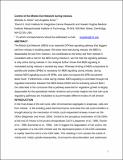Control of the mitotic exit network during meiosis
Author(s)
Attner, Michelle Andrea; Amon, Angelika B
DownloadAttner-2012-Control of the Mitot.pdf (870.3Kb)
PUBLISHER_POLICY
Publisher Policy
Article is made available in accordance with the publisher's policy and may be subject to US copyright law. Please refer to the publisher's site for terms of use.
Terms of use
Metadata
Show full item recordAbstract
The mitotic exit network (MEN) is an essential GTPase signaling pathway that triggers exit from mitosis in budding yeast. We show here that during meiosis, the MEN is dispensable for exit from meiosis I but contributes to the timely exit from meiosis II. Consistent with a role for the MEN during meiosis II, we find that the signaling pathway is active only during meiosis II. Our analysis further shows that MEN signaling is modulated during meiosis in several key ways. Whereas binding of MEN components to spindle pole bodies (SPBs) is necessary for MEN signaling during mitosis, during meiosis MEN signaling occurs off SPBs and does not require the SPB recruitment factor Nud1. Furthermore, unlike during mitosis, MEN signaling is controlled through the regulated interaction between the MEN kinase Dbf20 and its activating subunit Mob1. Our data lead to the conclusion that a pathway essential for vegetative growth is largely dispensable for the specialized meiotic divisions and provide insights into how cell cycle regulatory pathways are modulated to accommodate different modes of cell division.
Date issued
2012-06Department
Massachusetts Institute of Technology. Department of Biology; Koch Institute for Integrative Cancer Research at MITJournal
Molecular Biology of the Cell
Publisher
American Society for Cell Biology
Citation
Attner, M. A., and A. Amon. “Control of the Mitotic Exit Network During Meiosis.” Molecular Biology of the Cell 23.16 (2012): 3122–3132. Copyright © 2012 by The American Society for Cell Biology
Version: Final published version
ISSN
1059-1524
1939-4586